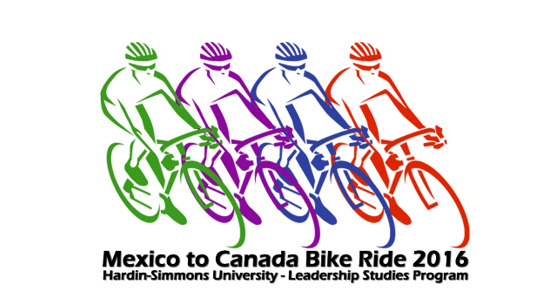
This long-distance bicycle ride as a laboratory for college students to practice the skills of leadership, teamwork, and organization seems to be taking on a life of its own. What started off as a one-time ride across Texas has grown into three trans-Texas rides and, most recently, one from the border with Mexico to the border with Canada. For nearly three weeks this past May and June, a group of 10 students, faculty, and friends rode as a team from Del Rio, Texas to the border north of Grand Portage, Minnesota.
A much bigger and more complex project than the three previous rides across Texas, the Mexico to Canada bike ride had been planned and prepared for since the early weeks of the Fall 2015 semester. From September through May, five students met weekly to determine the route, identify places to stay, make media contacts, raise funds, train, and secure equipment.
When originally formulating the goals of the ride and the route, students decided that they wanted a border to border ride rather than simply a ride from Abilene to Canada. They researched a number of options before deciding on the route from Del Rio to Grand Portage. One of the deciding influences on shooting for Grand Portage, besides the cool temperatures and beautiful scenery, was that I have family in Grand Marais, which is just south of Grand Portage. Hitting the border at that spot would give me some time with family and provide a built-in place to stay on our final night. When everything concluded, the final plan included a half-day to drive from Abilene to Del Rio, 14 days on bikes, two rest/weather days after the fifth and tenth days of riding, and two days to drive the team and gear back to Abilene—nineteen days in total.

Team members completed many training rides together and individually throughout the year, including an overnight out-and-back ride from campus to Possum Kingdom Lake State Park a month before the actual ride. Over the past few years, we’ve been able to build a collection of bicycles for the students to use. Donations and contributions allowed us to outfit all of the students in cycling shoes and clipless pedals. This year’s team was the best outfitted of any team from previous rides. And since the ride was twice as long as previous rides, that was a good thing.
To make the trip as economical as possible, the team would depend on the generosity of individuals, churches, families, former college students, and friends to provide us with lodging each night. In many cases, our hosts also fed and provided fun and relaxing conversation on our breaks.
The team traveled light. Each member brought one duffle bag with clothes, a sleeping bag, and a pillow. Most also carried a personal bag with on-the-road gear that could be accessed easily in the back of the car during the days. As with previous rides, a Honda Pilot and Chevy Silverado pickup were our transport and support vehicles. Each vehicle carried a four-bike rack and the pickup could carry one bike in the bed. Baggage, food, supplies, and water were spread across the two vehicles. Sleeping bags and pillows all went into a car-top carrier on the Pilot. During the ride, each vehicle also carried five people. It was a tight squeeze.
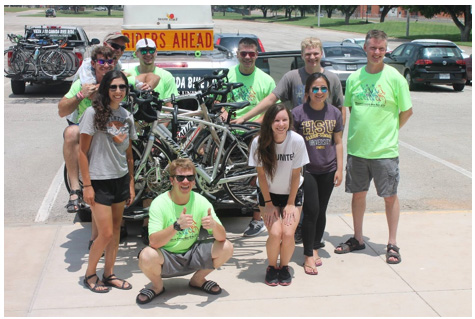
Loading and unloading became mechanical and very efficient over the journey. People took turns pumping bike tires, filling ice chests, packing the vehicles, and toting things out to be loaded. Toward the end, the entire team could go from sound sleep to packed and ready to roll in about 40 minutes. At the end of each day, the process was reversed and everything was unloaded for the night. Day after day, the cycle repeated itself.
The team loaded up and drove to Del Rio on Wednesday, May 25, 2016. We spent the evening with a congregation at a local church, who fed and welcomed us, and were hosted for the night at the home of one of the church members—in bunk cabins for visitors. The lodging was perfect for the team and a hearty home-cooked breakfast had us ready to roll the first morning.
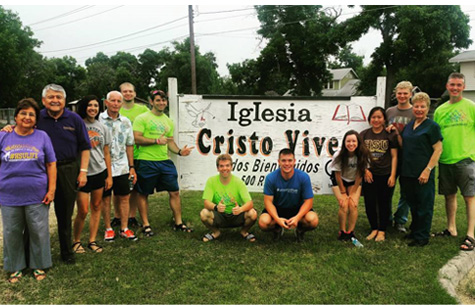
As a Leadership Workshop, the students enrolled in the class planned and prepared for the ride for months. Notebooks were created for each vehicle that outlined the route, elevation, distances, media contacts, emergency information, and host contact information for each day. Every detail that they could conceive had been planned and analyzed. However, once the ride began, plans adjusted depending on the weather, terrain, road conditions, traffic, wind, and team member health.
Each day, a different student served as “Road Captain.” Road Captains were responsible for guiding the team throughout the day. They were responsible for the route, times to wake up, methods of riding (group or leapfrog), distances and breaks, and making a myriad of on-the-road decisions that cropped up each day. The five students rotated through road captain responsibilities and each took three turns across the trip. The road captain element was a valuable addition to the class.
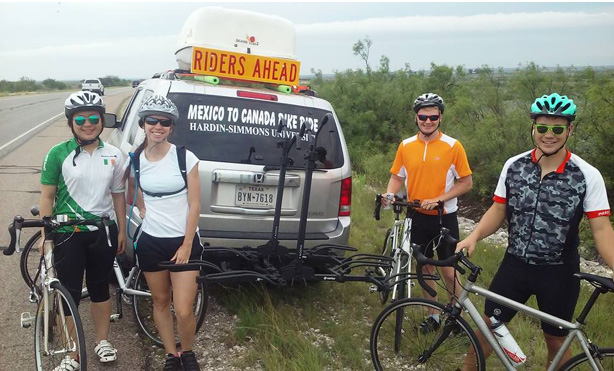
On Thursday, May 26, the team headed out from the edge of Lake Amistad on a 120-mile ride to Junction. The nervousness and questions that had been itching at the students for months quickly began to fade away. They could see that their planning and preparation was paying off. They had scoped out the roads on Google Maps and we had also driven the roads on the way to Del Rio. Steep rolling hills on the way into Junction were to be the greatest challenges of the day—along with the narrow shoulders on the winding road. In that section, we would use both support vehicles to warn traffic coming from behind us of the cyclists ahead. One vehicle would stick up close to the cyclists and the other would hang further back to give warning. Light traffic and courteous drivers made the ride as easy as it could be—those hills though!
First Baptist Church in Junction fed and hosted us for the evening. Our university’s vice president for enrollment management drove down to Junction with two of my kids to join us on the ride back to Abilene on the second day. As our enrollment VP, she wanted to gain first-hand experience with the ride so that she could better tell our story to prospective students and their parents.
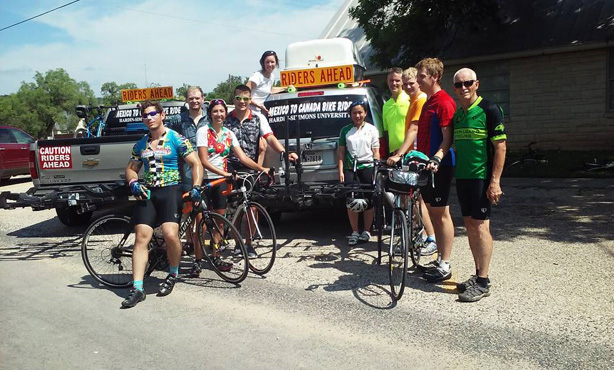
The second day took us from Junction through the hills to Menard and all the way back to campus in Abilene. It was a hot day and a nearly constant gain in elevation all the way to Tuscola made for long day. A group of supporters waiting and cheering for us at Hardin-Simmons University made our arrival back to campus fun and exciting. We had returned home, but the real journey was only just beginning.
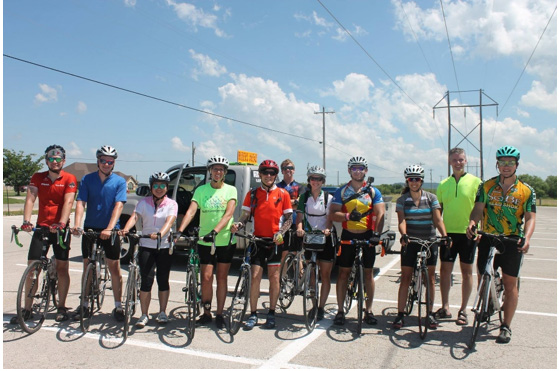
On the third day, a Saturday, a group of Steamboat Cycling Club members and some family members joined us on the ride from campus toward Seymour. This day would be one of our shortest distances to ride—slightly less than 100 miles. Instead of riding in our leapfrog style, where the cyclists in the two vehicles would ride 15 miles and then load up bikes and leap past the other team riding the next 15 miles, this day was mostly spent riding as a group. Throughout the day, the team had eight bikes out on the road and two team members driving the support vehicles. Except for the super windy days that were waiting for us in Nebraska and South Dakota, we typically had all bikes on the road and only one driver in each support vehicle at a time. Team members would take turns driving the support vehicles during each day.
We arrived at First Baptist Church in Seymour late in the afternoon. We unloaded, cleaned up, and found dinner at several local restaurants. A quick trip to a grocery store and Dollar General had us ready to settle in for the night and prepare for the next day on the road. We were up and moving early the next morning so that we would be gone by the time members started coming in for Sunday School. Kolaches, pigs in blankets, and donuts from a local donut shop gave us the hearty fuel that our bodies would need to get us moving on our fourth consecutive day on bikes—one that would take us into our second state.
It was a Sunday morning when we left Seymour heading to Duncan, Oklahoma. The biggest obstacle of the day was to be Wichita Falls. Instead of riding through the city, we veered off of 277 near Holliday and went east before heading up to Dean and onto Highway 79. The roads on that route were narrow with small shoulders, but less busy than what we would have encountered in Wichita Falls. Once on 79, we headed to the Red River and Oklahoma.
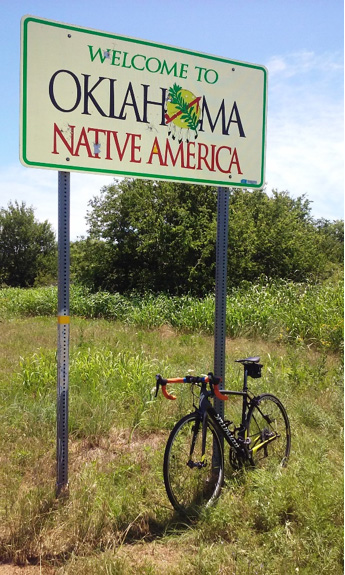
We arrived in Duncan, met with a newspaper reporter, and headed to our host home for the evening. A fantastic dinner and breakfast with our hosts prepared for the next day’s ride to Enid and our first planned rest day. In Enid, we invaded the home of a former student and her Air Force husband. It was in Enid that we began to get nervous about the upcoming weather forecast—heavy rain was predicted for the following three days. A strong thunderstorm actually rolled through in the early morning of our first night in Enid.
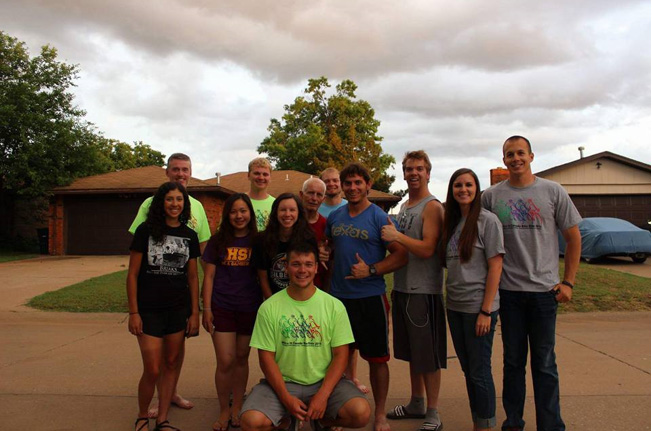
The next morning, after the storm passed over, we decided to forego our day of rest and gain as many miles as we could toward Kansas while the skies were clear and roads were dry. Heading north from Enid and then east past Blackwell, we turned north on Highway 77 toward the Kansas border south of Arkansas City. On the stretch to the border, we were hit by fast-moving showers. The rain wasn’t heavy enough to halt our riding, but it slickened up the already damp grass and mud on the shoulder of the highway.
As we approached the border with Kansas, the highway narrowed to a small-shoulder, two-lane road with rather heavy traffic—near a casino. Our team was riding in two groups at that time with the pickup truck team in the front. As my team approached the border in the Pilot, the traffic nearly slowed to a stop on the highway and ahead we could see our pickup truck sideways off the highway and perpendicular to the road. We also saw several bikes on the ground near the truck and some of our people running around near the truck. We thought that there had been an accident involving our cyclists on the narrow and busy road. We quickly pulled off the highway and drove on the slick shoulder to the scene of the chaos. Rather than finding an accident, we discovered that our truck had lost traction on the wet and muddy shoulder and its rear end slid off the shoulder and away from the road. The bikes and cyclists were running toward the truck to try to push it back onto the road. Once our whole group got together to block traffic and give a push, we got the truck back on the road and away from the congestion. Crisis averted!

After making it to the Kansas border, we drove 80 miles back to Enid for the night. The next morning, we drove back to that stopping point and started riding into Kansas from there.
Our first day in Kansas proved to be tricky. We had planned to ride Highway 77 to Augusta for the evening. A check of the roads using satellite views from online maps revealed that the shoulders were acceptable for riding, but the satellite images didn’t give us an indication of how heavily used those two-lane roads actually were—which turned out to be pretty heavy. Nearly constant truck traffic caused us to re-evaluate our route and make the jump to less-traveled, rural roads to Augusta. That change slowed us down a little, but turned out to be much safer and more scenic. In Augusta, we were hosted and fed by the Augusta United Methodist Church. Showers, dinner, and an opportunity to visit with the youth group made for a relaxed ending to a long day.
The next day of cycling took us through Abilene, Kansas before heading to Clay Center for the evening. Our home city, Abilene, Texas, was named after Abilene, Kansas. The ride from Abilene to
Abilene became a journey of goodwill. We had secured a proclamation of friendship from the mayor of our Abilene and carried a gift basket from our Convention and Visitors Bureau to deliver to city officials in Kansas. In the early afternoon of that day, we rolled into the Chamber of Commerce and Visitors Center in Abilene, Kansas to present their mayor and city officials with the gifts from Texas and to receive a hearty welcome and gifts to take back to Texas from Kansas. We learned about the rich history of Abilene, Kansas and took a guided tour of the Seelye Mansion before heading to Clay Center for the evening.

The departure from Clay Center, after a night at the National Guard Armory and meals with the grandparents of one of our cyclists, on the second Friday of our ride was the set up for the most favorable riding conditions of the journey. By mid-morning, when the sun had started to warm things up, the winds kicked up to a steady 20-25 mph from the south. The strong tailwinds continued throughout the day and all the way to our overnight destination in York, Nebraska.

After arriving and cleaning up at the community recreation center in York, we found food at a local pizza place and made a Walmart run to stock up on food for the road, sunscreen, and other necessary supplies. We visited with a former student and her husband who live near York and made a visit to the laundromat. The day riding to York was the fastest day of the ride, marked the mid-point of the journey in miles, and put us in the fourth of the six states on our ride.
The fabulous winds that pushed us to York turned on us the next day as we pedaled 155 miles to Yankton, South Dakota. By late morning, the winds were blowing steadily from the north at 25 mph with stronger gusts. At lunchtime, we decided to forego riding as teams and simply put one rider on the road at a time riding five-mile legs. The combination of wind and hills knocked our average speeds down from 20+ mph the previous day down to 9-11 mph this day. Although the day’s riding was brutal and demoralizing, the successful arrival into Yankton was extremely rewarding. A ride across the pedestrian bridge over the Missouri River, showers at our host church and member homes, a walk to the Yankton’s Rock and Ribs Festival, and time to relax topped off a hard, but rewarding day on bikes.
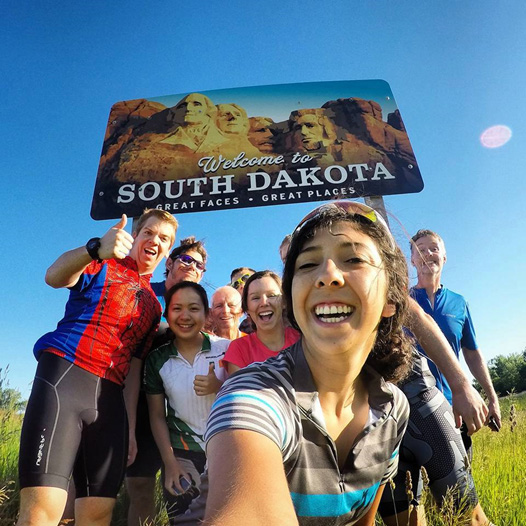
We left Yankton early on Sunday morning on our way to Watertown, South Dakota—we needed to be gone before people started coming in for church. The strong headwinds from the north on the previous day came more from the northwest on the way to Watertown. The riding strategy for most of the day involved putting two riders on the road at once and taking turns blocking wind and drafting. Switching positions every 1-2 miles allowed for relief while drafting and work while blocking. Many times while riding, it is hard to find the optimal drafting position with a partner. With this day’s hard and steady wind, it was quite easy to find the sweet spot while drafting. When we reached Watertown at the end of a second tough day of riding, we were ready for a day off.
Cornerstone Church welcomed and fed us for two nights in Watertown. Our day off was spent sleeping in, visiting the Redlin Art Center, shopping for supplies, driving to a bicycle shop in neighboring city to repair a broken spoke, making bicycle adjustments, visiting the local zoo, meeting with a newspaper reporter, and visiting with kind and gracious people at the church and in the community. We even met grandparents of an incoming Hardin-Simmons University student. After eleven straight days of cycling, it was very nice to have a relaxed and restful day off of the bikes.
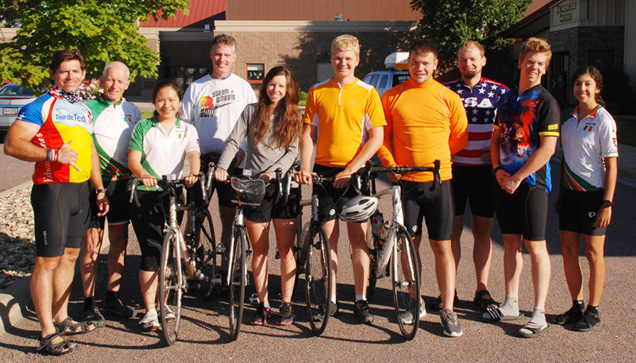
The ride out of Watertown was filled with excitement. We would cross into Minnesota, our final state, in the morning. With five states behind us, the crossing into Minnesota seemed like the beginning of the end of our journey. By the time that we reached New London for the evening, we had lost a transfer flag, confused a street number and a highway number, met and rode with a reporter in Willmar, and rode on our first bike trail. An easy after-dinner ride on the bike trail gave three of our riders 100+ miles for the day.

Leaving New London, we headed to Brainerd. The route was full of twists and turns and put us on rural highways, the Lake Wobegon cycling trail, and along busier four-lane highways. The day’s road captain had stayed up until 2 a.m. the previous night charting out and sharing the route. With a lot of communication between the two teams, we made it to and around Brainerd by mid-afternoon. To steal some miles from the next day, we rode past Brainerd and toward Aitkin. Going through Crosby, one of our cyclists clipped a curb with his front wheel and took a tumble in the grass next to the sidewalk. While not scraped up, he suffered a bruised rib that sidelined him from riding the next day. This was the only the second tumble experienced by one of our riders—one team member was scraped up when she caught her front wheel in a seam between two sections of concrete on the highway heading out of Enid, Oklahoma.
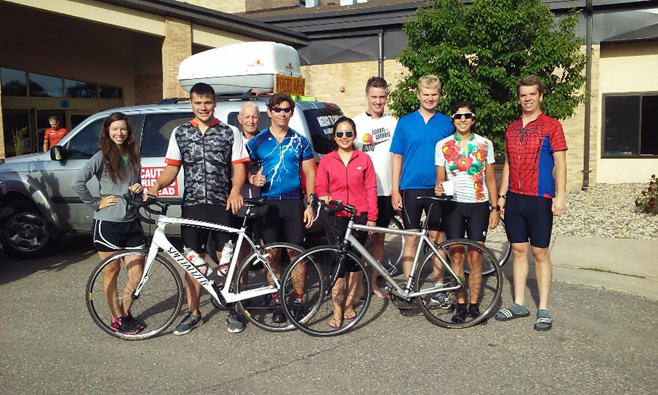
In Brainerd, we had time to visit at a local bike shop before meeting at our host church with members who would house our team in small groups at their homes. After two weeks of sleeping bags, inflatable mattresses, and occasional couches, it was incredibly nice to sleep in homes in real beds. Once again, we were amazed at the gracious hospitality of so many kind strangers—who quickly became friends.
As discovered riding beyond Brainerd the previous day, the planned road toward Duluth was much busier than what we had expected while planning the ride using online maps and satellite views. After consulting local cyclists in bicycle shops in Brainerd and Crosby, we decided to chart another route to Duluth that would eventually take us to Two Harbors for the night. The new route took us through Emily, Jacobson, and on other rural roads before dropping south through Twig into the north side of Duluth. The most congested roads of the entire ride were those heading into and around Duluth.
Once past Duluth, we were rewarded with our first views of Lake Superior. A stop at a lake-side park gave us time to admire the view, come up with a riding strategy to Two Harbors, take pictures, and put on warmer clothes. The temperature had dropped noticeably from earlier in the day once we dropped down to lake level. Combined with a stiff headwind and weary legs, the cold temperatures made for a tough ride to our overnight lodging in Two Harbors where we once again found extreme hospitality waiting for us at Living Waters Fellowship Church. Friendly conversation, hearty meals, and comfortable lodging was just what we needed in the lead up to our final day of cycling.

The thunderstorms that blew through early in the morning of the final riding day dropped temperatures into the 40s as we left Two Harbors and up the coast to the Canadian border. At times, the highway ran along the coast of Lake Superior near lake level and at other times, it rose up into the hills that bordered the lake. The final day also gave us bicycle trails that took us off the main roads and along the scenic shore of Lake Superior and over bridges and roaring rivers that emptied into the lake.
Before making the final push to the border, we stopped in Grand Marais to drop off some of our luggage at our overnight lodging and to pick up our host for the evening—my sister. My sister and her family have lived in the Duluth/Grand Marais area for years and were a big part of selecting the end point of the ride. By dropping off luggage at her house, it freed up space in the car to have her drive along with us to the border.
As we headed out of Grand Marais on the final push up the coast, dark clouds could be seen to the south and west. It became very apparent that we were racing the rain to the border. After more than 1,800 miles of cycling, we were getting our first serious threat of rain while on the road. Since we were still riding in the two-team format, each team had to just complete their designated 15-mile legs and then ride 10 miles together to the border.
At almost the precise time that the teams completed their 15 miles legs, the heavens broke loose. The torrential downpour made it impossible to complete the final 10 miles. While the rain came down, we decided to drive to the border and scout out the finish line—for the probable finish on the next morning. We talked with border patrol agents, stopped at a gas station near the border to fill up the vehicles, and visited a souvenir shop while it continued to rain. While we shopped, the storm blew through and the sky began to clear. A quick check of weather radar showed that the storms had blown out over the lake and the path was now clear for the final leg of the journey.
We drove back to the point where the rain had stopped our progress and unloaded all of the bicycles from the bike racks to complete the very last segment of the ride. Two flat tires and dropped equipment made for an interesting final leg. Once at the border station, the team walked their bikes to the middle of the bridge over the Pigeon River—the official border with Canada. We had done it! Lots high fives, pictures, and happy faces made for a memorable completion of the ride.
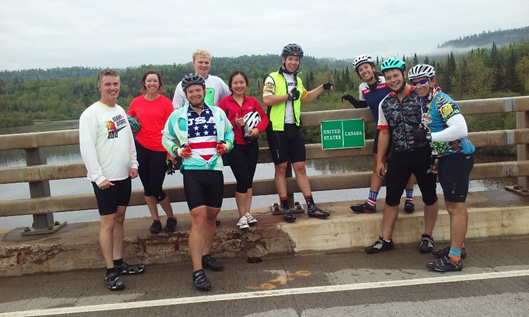
We spent the night in Grand Marais with family. Several of our folks made a frigid victory plunge into Lake Superior to cap off our final evening before heading home. More pictures, delicious food, fun conversation, and a restful night’s sleep helped prepare us for the 1,300 mile drive back to Abilene. Once back in Abilene we unloaded the vehicles, said our farewells and headed to our individual homes.
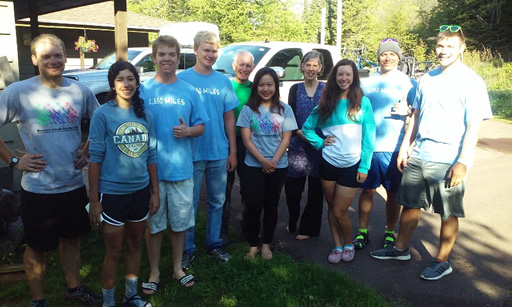
The Mexico to Canada Bike Ride exceeded our previous BRAT rides in every way. The planning, training, organization, media coverage, and complexity of the ride was tremendous and brilliantly executed. Students learned first-hand about working with others to successfully accomplish a big and complex project. We experienced ups and downs throughout the journey and we all reveled in the sense of accomplishment that came from turning our dream into a reality.
We were also reminded that in a world that seems so full of anger and distrust, good people abound. We were encouraged and supported by complete strangers throughout our odyssey. It was so refreshing and reassuring to know that incredibly gracious, generous, and giving people exist from border to border—we met a lot of them on our ride. We are looking forward to seeing what adventures wait for us on our next ride in 2017.
To learn more about this and previous rides, visit our website: www.BikeRideAcrossTexas.com.
Coleman Patterson
Director of Leadership Studies and Professor of Management and Leadership
Hardin-Simmons University